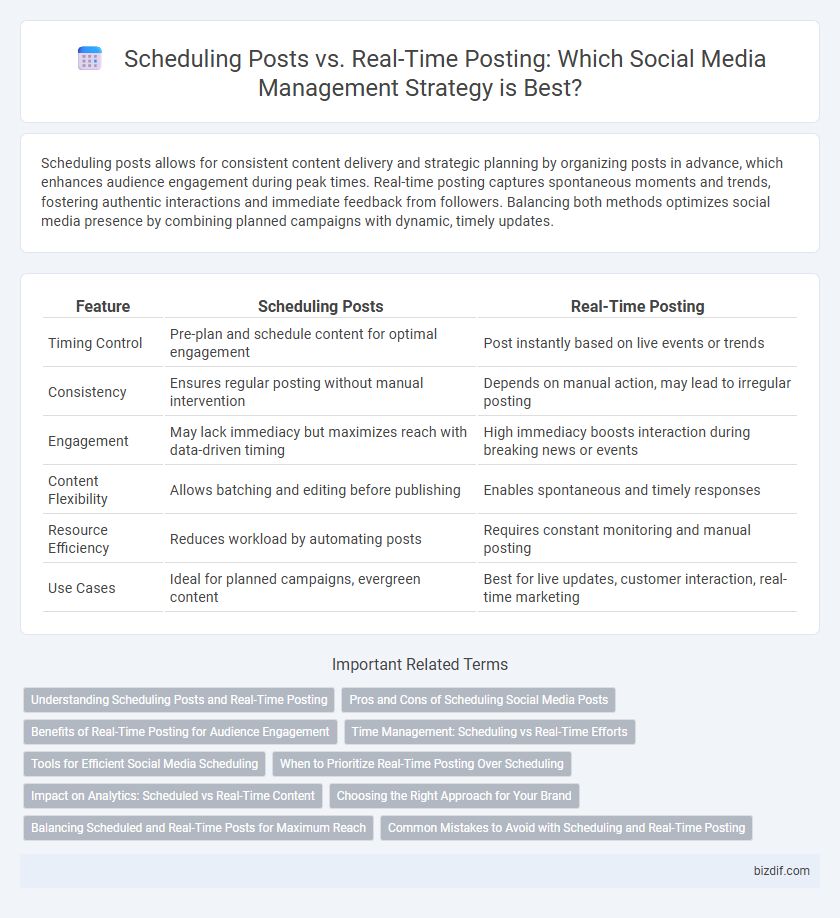Scheduling posts allows for consistent content delivery and strategic planning by organizing posts in advance, which enhances audience engagement during peak times. Real-time posting captures spontaneous moments and trends, fostering authentic interactions and immediate feedback from followers. Balancing both methods optimizes social media presence by combining planned campaigns with dynamic, timely updates.
Table of Comparison
| Feature | Scheduling Posts | Real-Time Posting |
|---|---|---|
| Timing Control | Pre-plan and schedule content for optimal engagement | Post instantly based on live events or trends |
| Consistency | Ensures regular posting without manual intervention | Depends on manual action, may lead to irregular posting |
| Engagement | May lack immediacy but maximizes reach with data-driven timing | High immediacy boosts interaction during breaking news or events |
| Content Flexibility | Allows batching and editing before publishing | Enables spontaneous and timely responses |
| Resource Efficiency | Reduces workload by automating posts | Requires constant monitoring and manual posting |
| Use Cases | Ideal for planned campaigns, evergreen content | Best for live updates, customer interaction, real-time marketing |
Understanding Scheduling Posts and Real-Time Posting
Scheduling posts allows social media managers to plan and automate content distribution across platforms, ensuring consistent engagement and optimal timing based on audience analytics. Real-time posting enables immediate sharing of trending news or spontaneous interactions, fostering authentic and timely connections with followers. Balancing scheduled content with real-time updates maximizes reach and responsiveness in dynamic social media environments.
Pros and Cons of Scheduling Social Media Posts
Scheduling social media posts allows for consistent content delivery, improved time management, and strategic audience targeting by posting during peak engagement hours. However, relying solely on scheduling can reduce spontaneity, delay responses to trending topics, and may lead to less authentic interactions with followers. Balancing scheduled content with real-time engagement is essential for maximizing reach and maintaining active community relationships.
Benefits of Real-Time Posting for Audience Engagement
Real-time posting enhances audience engagement by delivering content that aligns with current events and trending topics, increasing relevance and visibility. It fosters immediate interaction through timely responses and authentic communication, building stronger connections with followers. This approach boosts algorithm favorability on platforms like Instagram and Twitter, driving higher organic reach and interaction rates.
Time Management: Scheduling vs Real-Time Efforts
Scheduling posts streamlines time management by allowing social media managers to plan and automate content delivery during peak engagement periods, reducing daily workload. Real-time posting demands immediate attention and responsiveness, enhancing authenticity but requiring continuous monitoring and quick decision-making. Balancing scheduled content with timely interactions boosts efficiency and fosters genuine audience engagement.
Tools for Efficient Social Media Scheduling
Tools like Buffer, Hootsuite, and Sprout Social enable efficient scheduling of social media posts, allowing users to plan content in advance and maintain consistent posting times across multiple platforms. These scheduling tools offer features such as analytics, collaboration options, and automated posting, which enhance productivity and audience engagement. While real-time posting can capture immediate trends, leveraging scheduling tools optimizes resource management and ensures a steady online presence.
When to Prioritize Real-Time Posting Over Scheduling
Real-time posting is essential during live events, breaking news, or trending topics where immediacy drives engagement and relevance. Prioritize real-time updates when your audience expects timely information or interaction, such as during product launches or customer service responses. Scheduling remains effective for consistent content delivery, but real-time posting enhances authenticity and responsiveness in dynamic social media environments.
Impact on Analytics: Scheduled vs Real-Time Content
Scheduling posts enables consistent publishing patterns that boost engagement metrics by targeting peak user activity times identified through analytics. Real-time posting captures trending moments with high immediacy, driving spikes in interaction and reach, but may result in less predictable performance data. Balancing scheduled content with real-time updates optimizes overall analytics by leveraging both steady audience engagement and timely relevance.
Choosing the Right Approach for Your Brand
Scheduling posts enables consistent content delivery and optimal timing based on audience analytics, improving engagement and reach. Real-time posting captures timely trends and authentic interactions that foster stronger brand connections and responsiveness. Brands must evaluate their goals, target audience behavior, and resource capacity to select an approach that maximizes impact and aligns with their social media strategy.
Balancing Scheduled and Real-Time Posts for Maximum Reach
Balancing scheduled posts and real-time posting enhances social media engagement by combining consistent content delivery with timely interactions. Scheduled posts ensure a steady presence and maintain brand voice, while real-time posts capitalize on trending topics and audience responsiveness. Strategic use of both methods maximizes reach, driving higher engagement and fostering authentic connections with followers.
Common Mistakes to Avoid with Scheduling and Real-Time Posting
Scheduling posts can lead to common mistakes like poor timing and lack of responsiveness, causing missed engagement opportunities on social media platforms. Real-time posting risks inconsistent content quality and potential errors due to rushed creation under time pressure. Balancing scheduled content with timely, authentic interactions ensures optimized audience reach and improved brand credibility.
Scheduling posts vs Real-time posting Infographic

 bizdif.com
bizdif.com